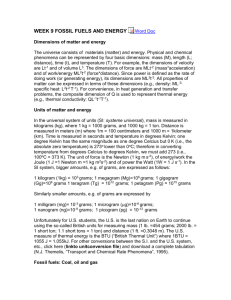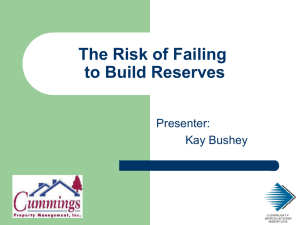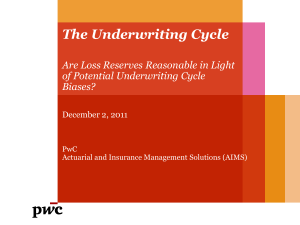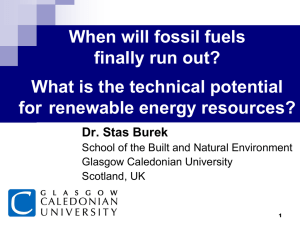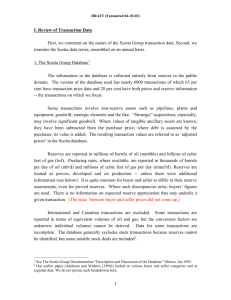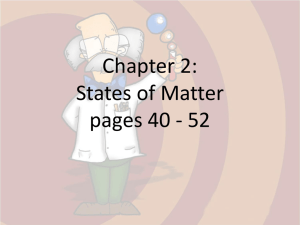Week 2 materials ppt
advertisement
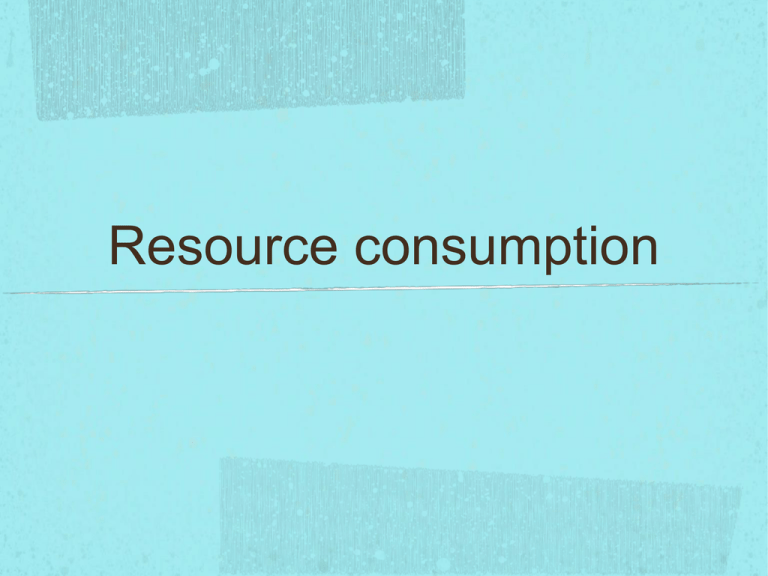
Resource consumption Rates of growth Linear, exponential, geometric Some resources are so abundant we don’t think about exhaustion Al, Ca, Cl, H, Fe, Mg, N, O, K, Si, Na, S We should be careful about alarms. In 1930, it was stated that our resources of copper will last 30 more years. In 2008 is was stated that our resources of copper will last 30 years. Annual world production (tons/yr) Use of materials by class (tons) Sources of Energy Sun wind wave hydro solar thermal photovoltaic Moon Tidal Nuclear decay Energy use by source (ExoJoules/yr) Global energy consumption by source Global energy consumption by use Chemical Types of Energy fossil fuels, batteries, refined materials Radiation RF, microwave, infrared, optical, X-ray, gamma... Thermal high grade and low grade heat Electrical and Magnetic static and oscillating fields Mechanical potential and kinetic energy Conversion Energy can be converted from one form to another. The efficiency, , tells us how well we convert (and how much is lost) Losses Energy conversion usually has low grade heat as a by-product, which is lost. Exception is electrical to thermal, which has 100% efficiency Refining of metals, for example, involves conversion of thermal or electrical energy to chemical energy. Theoretically that energy could be recovered by allowing the metal to oxidize again. But the effiency is too low to be useful. Conversion Efficiencies There are limits to the conversion efficiencies. Consider thermal to mechanical. Carnot taught us that where Tin is the temperature entering the heat engine and Tout is the exit temp. Carnot Efficiency with 150 C output Approximate efficiency factors Conversion path Efficiency kg CO2/MJ Fossil fuel to thermal (enclosed) 100 0.07 Fossil fuel to thermal (vented) 65-75 0.1 Fossil Fuel to electric 33-39 0.2 Fossil fuel to mechanical (steam turbine) 28-42 0.17 Fossil fuel to mechanical (gas turbine) 46-50 0.15 Electric to thermal 100 0.2 Electric to mechanical (elec motors) 85-93 0.23 Electric to chemical (battery) 80-90 0.24 Electric to EM radiation (incand lamp) 15-20 1.17 Electric to EM radiation (LED) 80-85 0.23 Light to electric (PV) 10-20 0 Water Water and materials Growth of natural materials (some irrigated, some not) Cooling cycles (with evaporative loss) Dust suppression Washing Water to produce energy Energy source Water used (l/MJ) Grid electricity 24 Industrial electricity 11 Energy direct from coal 0.35 Energy direct from oil 0.3 Reserves a mineral Reserve, R, is that part of a known deposit that can be extracted legally and economically at the time it is determined. Reserves are an economic construct, which change depending on economics, technology and legislation The Resource Base is the real total. This includes things we don’t know how to extract and estimates unknown deposits. Reserves vs. Resource Base Rich already exploited Reserves Improved mining tech Increased prospecting Resource Base Lean Certain Geologic Certainty Uncertain Reserve movement Commodity price (increased prices, increases reserve) Improved technology (increase reserve) Production costs (increased costs, reduce reserve) Legislation (can go either way) Depletion (if production exceeds discovery, reduces reserve) Time to Exhaustion Balance between supply and demand Suppose the reserve is R, measured in total tons of material Let P be the production rate measured in tons per year. The the static index of exhaustion, tex,s will be tex,s = R/P Dynamic Index The static index of exhaustion assumes there is no growth. Production rate can increase, for example. If r is the rate of production increase per year, then the dynamic exhaustion is Copper: dynamic and static indices Market Efficiency We are assuming an efficient market - the supply and demand are in balance If demand increases, then technology/economics offset. What happens if the market forces don’t work? Market Breakdowns Supply chain concentration depend on a few countries/regions... if there are problems... Cartel Action Stock piling Substitutions Recycling Real criticality issues The criticality of a resource is actually more complicated. The resource base is finite (although partly unknown). The reserves increase for a while and then decrease when prospecting is saturated. The exploitation (production) begins to consume the reserve, reducing it. At some point, the rate of production exceeds the rate of discovery. Then prices rise, and criticality is pending. Rate (tons/year) Price Production rate Rate of discovery Time Indicators of criticality Rate of growth of discovery falls below rate of growth of production Production rate starts to decline Minimum economic ore grade falls Prices start to rise Real curves are not smooth... Production and discovery Reserves Exercise Consider the following data about a resource (next slide). Examine the trends (graph price, production and reserves vs time). What conclusions can you reach? Calculate the static index of exhaustion. What does the result suggest about the reserves? Resource data for exercise Year Price ($/kg) World production (Mtons/year) 1995 2.93 9.8 310 1996 2.25 10.7 310 1997 2.27 11.3 320 1998 1.65 12.2 340 1999 1.56 12.6 340 2000 1.81 13.2 340 2001 1.67 13.7 340 2002 1.59 13.4 440 2003 1.78 13.9 470 2004 2.86 14.6 470 Reserves (M-tons)

